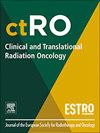前列腺放射治疗中减少神经血管束剂量的挑战与机遇
IF 2.7
3区 医学
Q3 ONCOLOGY
引用次数: 0
摘要
背景与目的:前列腺癌放射治疗(PCa)后神经血管束(NVB)的辐射损伤与勃起功能障碍有关。使用共面和非共面自动治疗计划的NVB节约在两种情况下提出:(1)不影响目标覆盖,(2)允许目标覆盖折衷。材料和方法:20例既往治疗的局限性PCa患者。基于MRI-CT匹配,回顾性地划定NVB。所有治疗计划(5 × 7.25 Gy)均采用Erasmus-iCycle(内部自动治疗计划算法)自动生成。Non-NVB sparing (non-NVBsparing)计划和NVBsparing计划在两种设置下生成:(1)uncompromise NVBsparing (u-NVBsparing);维持目标覆盖)(2)和受损的NVB保存(c-NVBsparing);允许目标剂量不足)。比较了共面和非共面光束的排列方式。将U-NVBsparing与non-NVBsparing进行比较。C-NVBsparing计划在Pareto前线可视化。统计学意义(p-value <;0.05),经Wilcoxon sign -rank检验。结果:与非nvbsparing方案相比,u-NVBsparing方案中位NVB D0.1 cc(共面组38.9 Gy vs 42.6 Gy;非共面38.9 Gy vs 43.3 Gy)和Dmean(共面25.6 Gy vs 30.0 Gy;非共面为24.7 Gy vs 30.2 Gy)。在c-NVBsparing方案中,进一步降低NVB D0.1 cc与较低的目标覆盖率明显相关。与共面方案相比,非共面c-NVBsparing方案在相似的NVB D0.1 cc值下保持了显著更高的目标覆盖率。结论:在不影响目标覆盖的情况下保留NVB是可行的。与共面NVB保留计划相比,非共面NVB保留计划没有发现临床相关的益处,尽管总体上有统计学优势。NVB的进一步节省是以目标覆盖率为代价的,为此,帕累托前沿可以用作临床实践中的工具。本文章由计算机程序翻译,如有差异,请以英文原文为准。
Challenges and opportunities to minimize the dose in the neurovascular bundles during prostate radiotherapy
Background and purpose: Radiation damage to the neurovascular bundles (NVB) has been linked to erectile dysfunction after prostate cancer radiotherapy (PCa). NVB sparing using coplanar and non-coplanar automated treatment planning is presented here in two settings: (1) without compromising target coverage, (2) allowing target coverage compromise. Material and methods: 20 previously treated patients with localized PCa. Based on a MRI-CT match, the NVB were retrospectively delineated. All treatment plans (5 × 7.25 Gy) were automatically generated using Erasmus-iCycle (in-house automated treatment planning algorithm). Non-NVB sparing (non-NVBsparing) plans and NVB sparing plans in two settings were generated: (1) uncompromised NVB sparing (u-NVBsparing; maintaining target coverage) (2) and compromised NVB sparing (c-NVBsparing; allowing target underdosage). Coplanar and non-coplanar beam arrangements were compared. U-NVBsparing was compared to non-NVBsparing. C-NVBsparing plans were visualized in Pareto fronts. Statistical significance (p-value < 0.05) was determined by Wilcoxon signed-rank test. Results: u-NVBsparing compared to non-NVBsparing plans showed statistically significant median reductions in NVB D0.1 cc (38.9 vs 42.6 Gy for coplanar; 38.9 vs 43.3 Gy for non-coplanar) and Dmean (25.6 vs 30.0 Gy for coplanar; 24.7 vs 30.2 Gy for noncoplanar). Further lowering NVB D0.1 cc in c-NVBsparing plans clearly correlated to lower target coverage. Non-coplanar c-NVBsparing plans maintained significantly higher target coverages for similar NVB D0.1 cc values, compared to coplanar plans. Conclusion: NVB sparing without compromising target coverage is feasible. No clinically relevant benefit was found for non-coplanar compared to coplanar NVB sparing plans, although overall statistically superior. Further sparing of the NVB comes at the cost of target coverage, for which a Pareto front could be used as a tool in clinical practise.
求助全文
通过发布文献求助,成功后即可免费获取论文全文。
去求助
来源期刊

Clinical and Translational Radiation Oncology
Medicine-Radiology, Nuclear Medicine and Imaging
CiteScore
5.30
自引率
3.20%
发文量
114
审稿时长
40 days
 求助内容:
求助内容: 应助结果提醒方式:
应助结果提醒方式:


